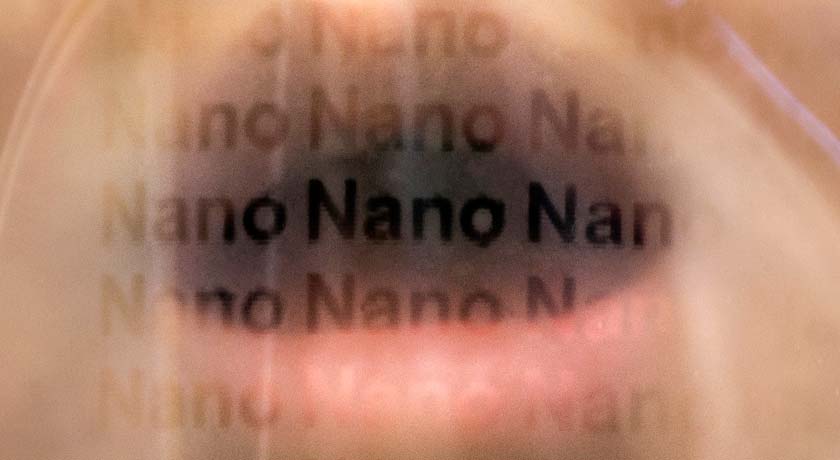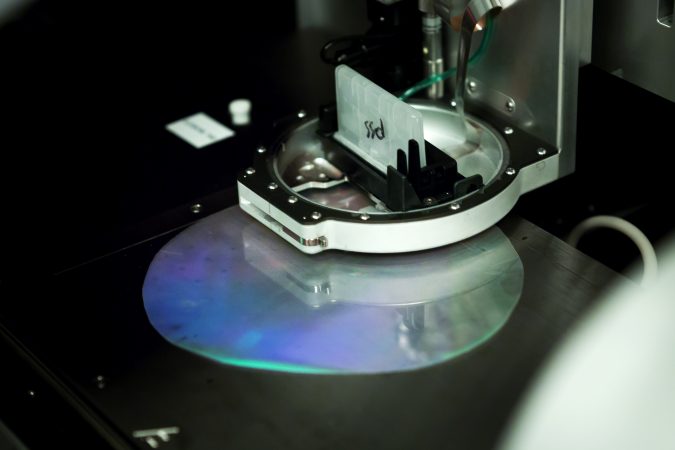Invisible plastic ‘ink’ foils counterfeiters
Just exhale to reveal the invisible ink on a new generation of safety labels

Terry Shyu exhales on a piece of plastic to reveal a message in a new, invisible ink — here printing out the term nano.
Joseph Xu, Michigan Engineering & Communications
A new plastic label offers an easy way to tell if medicine or some other product is the real deal or not: Just breathe on it. If the clear label is genuine, a hidden image appears. It’s the latest version of the classic watermark used to identify certain paper documents as authentic.
Here’s how the new plastic watermark works: It starts with polymers — chain-shaped molecules that are the basis of many plastics. Engineers use one clear polymer for the label; this polymer repels water. Then they apply another polymer that attracts water. It acts like invisible ink. Water vapor in an exhaled breath reveals the inked image printed using the second polymer.
It’s the difference in how the two polymers respond to a breath that makes this watermark work. They create “a contrast so we can see the image,” explains Terry Shyu. She’s a materials science graduate student at the University of Michigan in Ann Arbor. She worked on the new design with other researchers there and in Korea.
The label looks and feels totally smooth. But it’s not. Billions of tiny towers — called nanopillars — form an array, or grid, upon it. It’s almost like a tiny transparent Lego® base plate. The grid can’t be seen with the unaided eye, though. That’s because the diameter of each nanopillar is roughly one millionth the width of the average human hair.
After the nanopillars are molded, an inkjet printer applies nanoscale layers of the polymer ink. The process works a lot like a regular inkjet printer but with much thinner inked layers.
The nanopillars greatly increase the surface area that can hold the special ink. Thus, each part of the label’s area becomes much more water-attracting or water-repellant.

“You can steer light with nanopillars,” explains Joel Ager. A materials scientist at Lawrence Berkeley National Laboratory in Berkeley, Calif., he explores how nanopillars can help make solar cells more efficient. He did not work on the label design.
On the anti-counterfeit labels, the nanopillars diffract light. This bending and spreading of light waves makes the clear label material iridescent, flashing different colors.
“Even without any images, they look like a rainbow,” notes Nicholas Kotov, who works with Shyu at Michigan. A similar type of natural nanopillar on butterfly wings makes them look iridescent too, he explains.
The new label’s nanopillars are rugged. “They will not be destroyed by rubbing,” Kotov told Science News for Students. That keeps the hidden image from wearing off before someone buys a labeled product.
Getting the nanopillars to be both very small and very strong took lots of trial and error, says Shyu. Imagine molding lots of chocolate cups with a layer of chocolate connecting them all. If everything isn’t just right, bits would break off, or gooey stuff would stick to the mold.
But the good news: Making the labels is relatively cheap. Production requires a high-tech facility. “But it’s not expensive high-tech,” Kotov says. And the nanopillar sheets can be made as big as a square meter. Lots of labels could be made on one sheet and then cut to size.
This makes the new design practical enough for manufacturers to use. The research team’s Aug. 6, 2014, report in Advanced Materials shows examples of the label material on glasses, a tee shirt, a glove and a plastic cup.
“It’s very significant that they were able to make such large areas,” notes Ager. The nanopillar arrays that Ager works with are much smaller — about one centimeter (0.4 inch) square.
One centimeter is about the width of your pinky tip. Nanopillar sheets need to be bigger before they can be practical for commercial use in solar cells, electronics or other products. So the method for molding the new nanopillar sheets could be helpful in other areas, Ager says.
While manufacturers could start using the label-making process now, counterfeiters couldn’t do that, Kotov suspects. It’s unlikely they would have access to the necessary high-tech equipment.
One use where the new labels might become practical right away is in identifying medicines. Criminals sometimes sell fake versions of some drugs, such as those for cancer and malaria. People need a way to see if what they are buying is real.
The new label design offers a way to protect those patients from buying drugs that may not work — or might even kill them. “The ability to distinguish if it is safe or not needs to be incorporated in the packaging,” Kotov says.
Power Words
array A broad and organized group of objects. Sometimes they are instruments placed in a systematic fashion to collect information in a coordinated way. Other times, an array can refer to things that are laid out or displayed in a way that can make a broad range of related things, such as colors, visible at once.
cancer Any of more than 100 different diseases, each characterized by the rapid, uncontrolled growth of abnormal cells. The development and growth of cancers, also known as malignancies, can lead to tumors, pain and death.
diffraction The bending of waves when they hit an object. The pattern produced by those waves can be used to determine the structure of very tiny objects, such as the width of a human hair.
grid (in mathematics or mapping) A network of lines that cross each other at regular intervals, forming boxes or rectangles, or an orderly field of dots that mark where each pair of lines intersect (cross one another).
iridescent Adjective that describes something that seems to change color with a shift in the angle at which it is viewed or lighting is applied.
malaria A disease caused by a parasite that invades the red blood cells. The parasite is transmitted by mosquitoes, largely in tropical and subtropical regions.
materials scientist A scientist who studies how the atomic and molecular structure of a material is related to its overall properties Their analyses of a material’s overall properties (such as density, strength and melting point) can help engineers and other researchers select materials that best suited to create or improve products and processes.
nano- A prefix indicating a billionth. It’s often used as an abbreviation to refer to objects that measure in the billionths of a meter in length or in diameter.
nanotechnology Science, technology and engineering that deals with things and phenomena at the scale of 100 billionths of a meter or less.
physics The scientific study of the nature and properties of matter and energy. Classical physics An explanation of the nature and properties of matter and energy that relies on descriptions such as Newton’s laws of motion. It’s an alternative to quantum physics in explaining the motions and behavior of matter.
plastic Any of a series of materials that are easily deformable; or synthetic materials that have been made from polymers (long strings of some building-block molecule) that tend to be lightweight, inexpensive and resistant to degradation.
polymer Substances whose molecules are made of long chains of repeating groups of atoms. Manufactured polymers include nylon, polyvinyl chloride (better known as PVC) and many types of plastics. Natural polymers include rubber, silk and cellulose (found in plants and used to make paper, for example).
transparent Allowing light to pass through so that objects behind can be distinctly seen.
watermark A subtle image imprinted on paper, usually visible only when held in a particular direction or up against light. This centuries-old technology helps establish a document as genuine to thwart counterfeiting. In the 1990s, new “digital watermarks” emerged that superimpose a light image on top of a document or photo (or sound on top of an audio file) to identify the creator.







